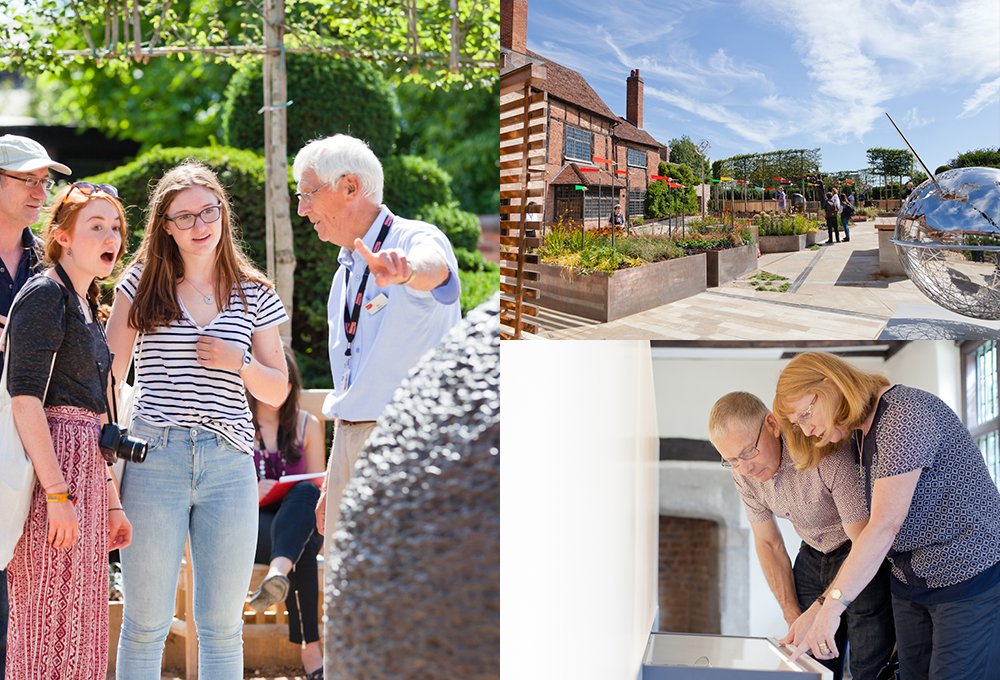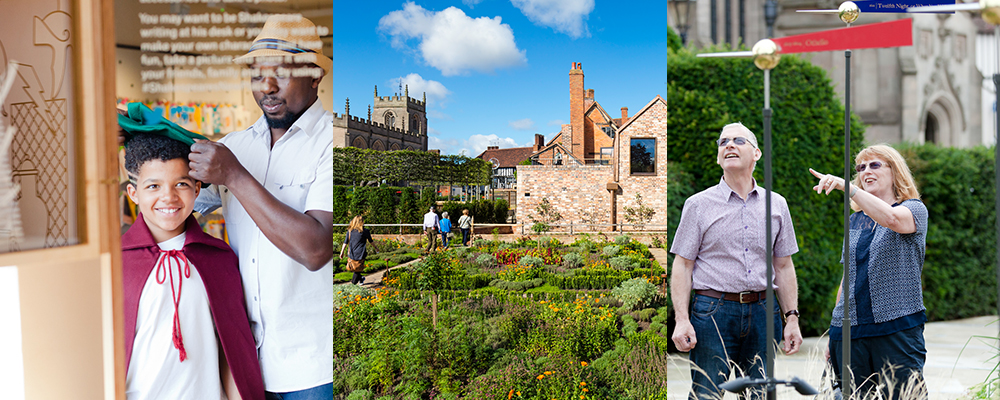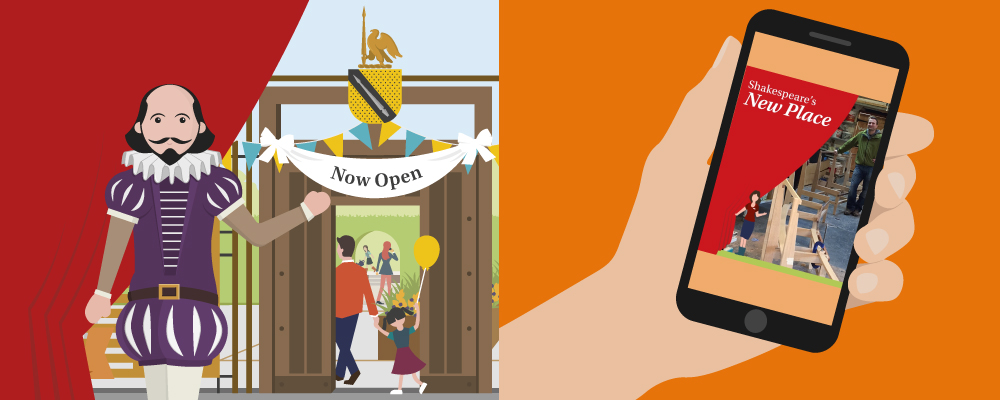Arts and culture: How to handle the new
All arts and culture organisations have to evolve to thrive. When you plan a new offering and get the funding to make it happen, you spend it according to a bigger plan – one the public doesn’t always have sight of.

Images: Shakespeare’s New Place, the latest offer from the Shakespeare Birthplace Trust, opened in 2016
You know your new attraction, exhibition or show coheres perfectly with your broader strategy. But how do you ensure your audience is excited and engaged with this shiny new offering? I’m going to shed some light on this question with the help of a launch campaign we created for the Shakespeare Birthplace Trust:
- Going back to the basics of purpose and audience
- Accurately estimating the power of emotion
- Keeping an eye on the practicalities
- Staying in touch with teams on the front line
–
But first, a bit of scene-setting. The drivers and motivations that got your project funded and delivered are not necessarily (in fact, are rarely) the same messages that excite your audiences. You need to communicate in terms of what’s important to them.
For the purpose of this post, let’s split audiences into two broad segments: day-trippers and loyal supporters.
Day-trippers
Day-trippers are new to you and probably not especially invested, looking for a good day out, or to tick off a must-do experience. For them, the best impression of your new offering is an added bonus (especially if it’s included in the same ticket price). At worst, it’s a cause for confusion and flouted expectations.
Loyal supporters
Loyal supporters are a trickier bunch. They will have a greater sense of ownership, and a stronger emotional response to the new. If you fail to ensure your new offering fits with your established story, you fall short of their expectations. Worst case: you lose their loyalty, as they start to question whether you’re still relevant to them.
The consequences of letting anything woolly or inauthentic slip through the cracks are significant. In my experience, the key is to weave the new offer into your story in a way that feels inevitable, so to your audience, it feels like the next logical step in your history.
How do you lay the foundations for a successful launch, and create a clear narrative between what’s new and what came before, while engaging your loyal supporters, delivering for your day-trippers, and being relevant and exciting to both?
Back to basics
Go back to your purpose
What is the point of your organisation? How often do you remind your audience about it? Are you communicating how your new offering fulfills that purpose?
In 2016, we worked with the Shakespeare Birthplace Trust to launch Shakespeare’s New Place (the site where Shakespeare’s house used to be). In the pre-launch communications, we reminded audiences about the Trust’s established roles: to care for the world’s greatest Shakespeare heritage sites, and to promote enjoyment and understanding of his works, life and times across the world.
New Place is unlike the other four sites the Trust opens to the public, because it has no Tudor or Jacobean property on it. The project presented an opportunity for the Trust to fulfill its established purpose, and help people make connections with Shakespeare, in an innovative, imaginative and altogether different way. This central purpose led the key messaging for our campaign work.
Evaluate your audience
Come back to what you know about your audiences. Why do they choose you over and over again, or for the first time?

We knew people would come to this historic site – not just because it’s the Trust’s newest attraction, but also to learn about this little-known period in Shakespeare’s personal life. For some audiences, their visit is a kind of pilgrimage: it was important not to underestimate the power of standing in the place where he produced some of his greatest works. More broadly, the Trust is seen as the authoritative and authentic source for all things Shakespeare.
These insights were the foundation for integrated campaign activity across two stages: fundraising, and launch. The fundraising comms invited potential donors to sponsor parts of the new site. We illuminated the personal side of Shakespeare’s story, championed the Trust’s work, and uncovered the way in which Shakespeare’s works, life and times inspired the artists behind the sculptures and installations available for sponsorship. This clearly connected the Trust’s existing activities with the plans for Shakespeare’s New Place.
Use emotion – it’s a powerful tool
It’s a watchword because it’s essential. Successful retail brands know our buying decisions are emotional and instinctive. To get your audience to put faith, time and money in your new venture, your story needs to draw on the emotive.
This is especially important in the heritage and museums space. Without the emotive connection, you risk the dreaded perception of being a dusty organisation, whose only relevance is to the past.
Throughout the launch campaign, we captured the emotion behind Shakespeare’s New Place by telling the site’s unique story from many different angles: from the way he inspired the artists creating work for the site to his intriguing personal stories. We painted a picture of Shakespeare the landowner, businessman and father, corresponding with key touch points of the new exhibition.
The campaign was umbrellaed with the concept “His footsteps, your journey”. We connected the past with the present and put the visitor in Shakespeare’s shoes with simple, emotive language.
Practicalities
Often something new entails a quiet doing-away with something old. Some of your loyal supporters will have loved that old thing, and think you’re making a terrible decision. While the proof of the pudding will be in front-line interactions and ticket sales, you (and your PR team) need to think about how to communicate the change and smooth the transition.

Changing perceptions: educating the local audience
One of the Trust’s biggest challenges among the local community was the shift at Shakespeare’s New Place from a free public garden to a ticketed space. It was always part of the strategy for entry to be free to local residents and people who work in Stratford-upon-Avon.
We created leaflets for local homes and businesses, with clear instructions on how to claim free entry passes, updates on the latest developments, and employment and volunteering opportunities. These helped to alter perceptions that nothing of the previous garden would remain (much of it did), and address concerns that the change would result in high entry prices.
The missing house: educating everyone
The other significant practical challenge was the missing building. Historically, Tudor and Jacobean buildings had been the core of the Trust’s visitor offering. Campaign communications acknowledged the obvious physical difference, while maintaining a clear narrative promoting Shakespeare’s works, life and times, describing “the site of Shakespeare’s final home”.
Don’t forget: launch is just the beginning
The opening day or night can feel like an ending when you’re surrounded by the teams that created your new thing. For marketers, ops and other teams, it’s Day One. All your work on purpose, audience, emotion and practicalities is based on solid theory, and all of what you know to date about your offering and your audience. Now you get to put it to the test.
As it beds in, you’ll glean valuable insights into how to fine-tune the story you tell. This is where a solid strategy and ongoing communication between teams is critical.
A little while after New Place’s opening, some feedback came through from the ops team. The clear-but-wordy “site of Shakespeare’s final home” wasn’t getting through. Visitors were turning up expecting a house (based on what they already knew about the Trust) and being disappointed.
Because we had anticipated this from the outset, we were already working closely with teams across the Trust to manage the issue, reviewing copy and assessing customer feedback together. Clearly we needed to recalibrate the way we introduced New Place pre-visit.
We now talk about “the house that isn’t there”, and the story of its demolition is explained across literature. On-site teams also responded quickly, devising a regular “Where’s the house?” talk; they do a great job of capturing and enlightening visitors on entry.
The new: handled
Launching Shakespeare’s New Place provided four lessons in ways to handle a new offering as an established heritage tourism brand:
- Get back to basics. Make sure the story of your new offering coheres with what’s already there – remember why you exist, and what audiences have come to expect from you.
- Use emotion to make that story relatable for audiences right across the spectrum.
- Keep an eye on the practicalities, and address any potential barriers to acceptance from the start with clear, consistent communication.
- Stay in touch: be responsive to feedback and ready to adapt.
Keep all of that in mind, and your customers will enjoy the new tricks, and continue to love the old dog too.
About Nicola
Nicola Edginton
Creative Director
Nic has a thorough understanding of, and passion for, brand. She has worked at mark-making* for over 15 years. Bringing fresh ideas and approaches to her projects, she has won multiple awards for her work. Nic’s role involves collaborating with the strategic and client leads, and the studio team, to shape the creative articulation of the brand as a visual and verbal identity. Nic has worked across a spectrum of B2B and B2C sectors, delivering diverse projects from identity creation and communications collateral to website design for brands such as F.Hinds, Nutricia, British Cycling, LV=, and The Shakespeare Birthplace Trust.